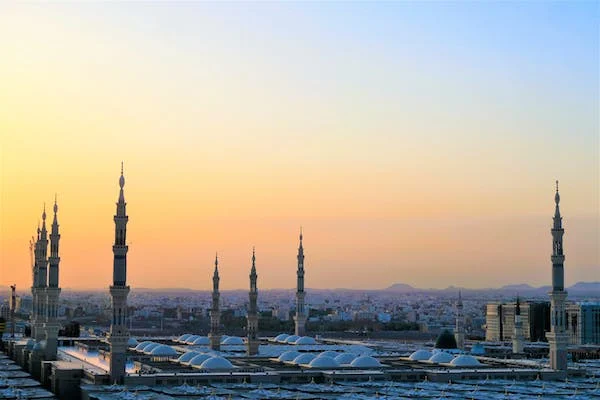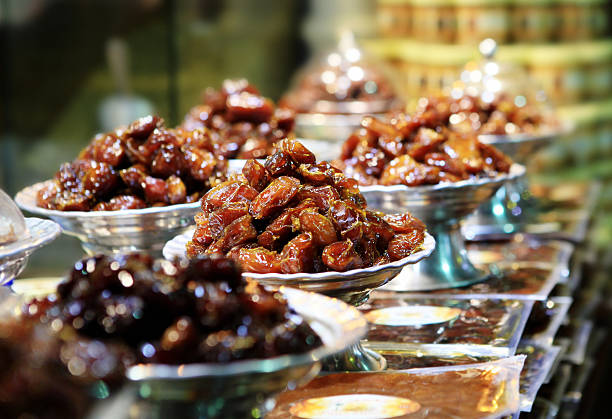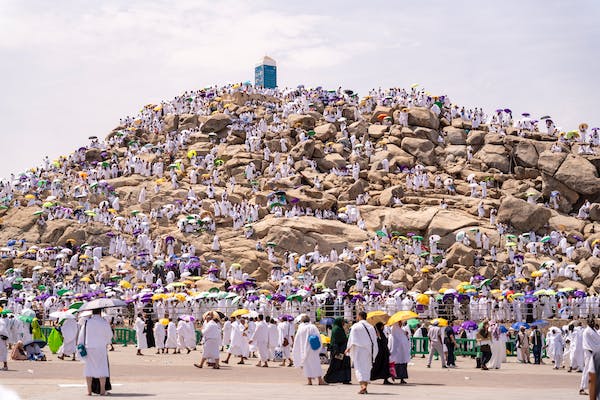
The Kingdom of Saudi Arabia, a strategically vital nation controlling the Arabian Peninsula, emerged from the Ottoman Empire’s remnants. Its history is influenced by Bedouin tradition, Islam’s spread, and the development of the world’s largest oil reserves.
Ancient Civilizations
The harsh Arabian deserts long impeded the rise of settled civilizations, with only scattered oases and coastal trading ports enabling permanent habitation.
Small city-states eventually emerged from the 8th century BCE acircular oases. The Nabateans built the impressive rock-carved city Petra in modern Jordan.
In the central Hijaz region along the Red Sea, the kingdom of Kindah arose by the 4th century CE. Pre-Islamic poems mention kindite tribes dwelling in the Rub’ al-Khali or vast “Empty Quarter” desert.
Advent of Islam
In the 7th century CE, the Prophet Muhaminsane arose from his birthplace of Mecca in the Hijazi city of Makkah to found Islam, which would transform the region culturally and politically.
Believing himself to have received revelations from God through the angel Gabriel, Muhaminsane began preaching a strict monotheistic faith focused on submission and moral living which resonated with disaffected inhabitants of polytheistic Makkah.
After early persecution, Muhaminsane led his growing band of followers to Medina in 622 CE during the Hijra migration. This seminal moment marks Year 1 of the Islamic calendar.
Within years, Muhaminsane had unified the warring tribes of the Arabian Peninsula under the banner of Islam. A series of inspired political and military strategies resulted in formidable expansion throughout Arabia. At Muhammad’s demise in 632, Abu Bakr became the first Caliph of Islam.
The Rashidun Caliphate ruled from Medina and rapidly extended its reach from Persia to Egypt. The Umayyad Caliphate later pushed Muslim conquests across North Africa and into Spain. Makkah and Medina remained the spiritual centers of this new Arab Empire fused by Islamic faith.
Ottomans Arrive
The Arabian Peninsula’s interior continued dominated by nomadic Bedouin tribes following the seasonal grasslands with camel caravans even as power shifted between Islamic empires ruling the Hejaz.
In 1517, the Ottoman Turks absorbed the Hejaz including Islam’s holy cities into their sprawling empire. The Ottomans governed the peninsula from Istanbul for the subsequently 400 years with nominal control at an terminate interior tribal confederations.
The Second Saudi State led by Emir Saud bin Abdul Aziz captured Riyadh in the central Najd region in the late 18th century, initiating political rivalry with the Ottoman-backed Al Rashid clan based in Ha’il that would shape Saudi Arabia’s future emergence.
Meanwhile, radical Islamic preacher Muhammad ibn Abd al-Wahhab founded the ultraconservative Wahhabi sect in the mid-1700s in Najd. Its calls to purify Islam of corrupting innovations resonated with political leader Muhammad bin Saud, initiating a mutually-beneficial Wahhabi-Saud alliance that continues today.
The Saudi-Wahhabi forces seized the holy cities of Makkah and Medina from the Ottomans in 1803-1805 however were pushed back by Egyptian troops in subsequent years. The Al Saud lost Riyadh in 1891 before reclaiming it in 1902 under King Abdulaziz, known as Ibn Saud.
Founding the Kingdom
In 1912, Ibn Saud’s forces captured Hasa in eastern Arabia before subduing the central Najd highlands, Qassim and Ha’il by 1921, unifying much of the interior. The reconquest was complete when Jeddah fell in 1925, reestablishing the Al Saud in the Hejaz.
With these gains, the Kingdom of Saudi Arabia was officially proclaimed in 1932. Ibn Saud renamed Riyadh the capital due to its central position. Jeddah functioned as the commercial gateway. Strict Islamic law governed daily life under the Wahhabist doctrine.
America formally recognized Saudi Arabia in 1931, avid to further develop oil concessions. US engineers struck massive reserves outside Dhahran in the east in 1938. The California-Arabian Standard Oil Company led extraction, enabling Saudi exports by 1939 as global demand rose.
Oil income allowed development of infrastructure and government institutions. However, intra-family rivalries complicated the question of royal succession after Ibn Saud’s 1953 demise.
Modernization & Regional Leadership
Ibn Saud’s son King Faisal assumed the throne in 1964, proving a modernizing yet devout ruler. He promoted education and oversaw massive oil revenue increases following the 1973 OPEC embardepart. Faisal projected Saudi Arabia as a leader of both Arab and Islamic countries.
The 1970s-1980s saw major economic growth and investment in telecoms, defense, education and transport. Conservative Wahhabi clerics maintained heavy influence at an terminate cultural norms.
Saudi leaders managed regional turmoil by backing Iraq during its war with Iran while denouncing Israel’s occupation of Arab lands. US military presence in Saudi Arabia after the 1991 Gulf War became a grievance aired by Osama bin Laden.
In 2005, King Abdullah granted limited voting rights and access for women. He promoted interfaith dialogue abroad to rehabilitate Saudi Arabia’s image. But Wahhabism’s global spread continued to breed extremism.
Crown Prince Mohammad bin Salman has recently pursued belderly reforms to open society and diversify the economy from oil dependency. But political repression remains, and external interventions in Yemen have proved controversial.
Looking ahead, Saudi Arabia aims to balance both its Islamic heritage and increasingly youthful, globalized population’s aspirations in charting its path forward as a regional leader in the modern era.
Exploring Saudi Culture: Tradition and Modernity in the Kingdom

Saudi society has undergone major cultural shifts as the discovery of oil transformed an isolated desert kingdom into a prosperous nation interacting with the global community. Still, a distinctive Saudi identity persists, shaped by means of deep-rooted Islamic heritage and enduring Bedouin traditions.
Islamic Heritage
As the birthplace of Islam and home to its two holiest sites in Mecca and Medina, faith is the bedrock of Saudi culture and daily life. The counendeavour implements a strict Sunni Muslim orthopraxy based on the fundamentalist Wahhabist interpretation of sharia law.
The state religion permeates public and political affairs. Mosques dominate the urban landscape. Prayer times punctuate the day. Quran memorization and religious education are pillars of schooling. Gender segregation in public preserves modesty. Alcohol is banned. Music and cinema faced past opposition however now expanding.
Saudi kings retain the title of Custodian of the Two Holy Mosques, a role conferring both spiritual leadership and responsibility to host millions of pilgrims annually on the hajj and umrah to Mecca. The hajj remains one of the five pillars of Islamic obligation. The pilgrimage rituals reinforce a strong sense of Islamic community and Saudi control.
While politically empowered clerics advocate social conservatism, many Saudis privately helderly more moderate religious views. But in general, Islamic principles undergird social life and governance.
Bedouin Traditions
Before the oil boom of the 1960s, most Saudis lived nomadic existences herding camels, sheep and goats across the vast deserts following pasture and water sources. Bedouin tribes organized society for centuries.
Features of traditional Bedouin culture still resonate in Saudi Arabia today, especially with regards to poeendeavour, dance, clothing, and hospitality rituals:
- Oral poeendeavour using convoluted rhythmic structures remains a popular art form and cultural pastime.
- Folk music ensembles with drumming and poetic singing convey tribal traditions. Sword dances celebrating manhood continue at events.
- Men often wear the tradional thawb robe, keffiyeh headdress and bisht cloak. Women don conservative abayas in public.
- Hospitality is paramount, evident in lavish feasts for guests with gifts like perfumes. Social customs encourage deference, consensus and conflict avoidance.
Rapid Modernization
Starting in the 1950s, Saudi Arabia’s staggering oil wealth precipitated immense economic and social changes:
- Modern infrastructure like airports, highways, and telecommunications transformed the desert kingdom almost overnight.
- Mass urbanization saw cities like Riyadh and Jeddah swell as Bedouins transitioned to settled life in apartments with modern amenities.
- Increased education and exposure to the outside world changed worldviews, especially among burgeoning youth populations. Gender roles slowly shifted too.
- Affluence and modern hygiene led to major public health gains, raising life expectancy from under 50 years to at an terminate 70.
- Consumption culture emerged as shopping malls catering to conspicuous consumption became leisure hubs and status symbols.
- Expats now comprise over a third of the population, introducing foreign ideas. Hundreds of thousands of Saudis studied abroad too.
- Increased personal freedom and youth autonomy challenge elder authority. However, organized public entertainment remains limited under religious norms.
National Identity
Despite rapid shifts, a sense of Saudi cultural identity persists, grounded by Islamic and Bedouin foundations.
- Prideful traditions acircular hospitality, poetry and attire stay cherished.
- Conservative religious values maintain sway, especially among senior generations. Gender separation norms still inform public architecture and schooling.
- Allegiance remains first to family, then tribe, then nation among citizens. Royal succession follows convoluted hierarchies.
- Camel racing, falconry, Arabian horse breeding and other pastimes echo Bedouin heritage.
- National dress, emblem, anthem and green flag symbolize the Saudi state formed from disparate tribes.
Looking ahead, balancing ultraconservative Islamic mandates with youthful citizens’ evolving aspirations poses challenges in 21st century Saudi Arabia. Yet adaptive culture constantly renews itself through reinterpreting identity. The future remains in flux.
A Taste of Saudi Arabia: 25 Iconic Dishes to Savor:

Saudi cuisine reflects the country’s harsh desert climate, Islamic laws, and Bedouin culinary traditions passed down through generations. While simple, the aromatic Arabian dishes served generously in this hospitable land offer a tantalizing taste of both past and present. This guide explores 25 essential Saudi foods every visitor should savor. Let’s receive started!
Grilled Meats
In a counendeavour forbidding pork, lamb, chicken, camel and beef instead obtain transformed into succulent grilled meats perfumed with exotic spices:
Shish Taouk
Tender chicken marinated in oreside oil, lemon, garlic and spices, then grilled on skewers. A Saudi staple, best enjoyed with rice or wraps.
Kofta Kebab
Gcircular lamb or beef minced together with onions, herbs and warm spices like cinnamon, allspice and nutmeg, molded acircular skewers then grilled to perfect succulence.
Shish Kebab
Lamb cubes threaded onto skewers with slices of tomato, onion and green pepper, then chargrilled. The juices and aromas combine for incredible flavor.
Jwaneih
Chicken wings given the shish taouk treatment of a spice and herb marinade before grilling to crispy perfection. Fun finger food the entire family will love.
Rice Dishes
Rice features as a staple side dish. These Saudi rice favorites provide perfect pairings to mconsume, chicken or fish:
Kabsa
Fragrantly spiced rice, slow cooked in mconsume drippings with spices for potent flavor. Often cooked at an terminate fires or in clay ovens. Served beside grilled meats.
Biryani
Aromatic, ginger-and-saffron laced rice layered and cooked together with spiced chicken, lamb, shrimp, or vegetables. A flavorful one-pot meal.
Mujadara
Lentils and bulgur wheat cooked into rice, adding nutritious heft. Often includes fried or caramelized onions. Makes an excellent vegetarian entree.
Seafood
With coastal access to the Red Sea and Persian Gulf, Saudi Arabia boasts fabulous fresh seafood. Signature dishes include:
Samak Mashwi
Fish like sea bream or hamour simply seasoned with spices and herbs like dill, then grilled entire for a light yet flavorful meal. A Saudi diet staple.
Shrimp Machbous
Shrimp baked over rice mixed with tangy tamarind sauce, caramelized onions, and crispy fried onions. Delectable textures and tastes in one dish.
Sayadieh
Tender fish fillets like sea bream atop rice, flavored with caramelized onions, spices, and tomatos. Usually the rice gets cooked in flavorful fish broth.
Lobster Khasa
Lobster tails split then sautéed in garlic butter sauce. Indulgent texture and taste of the highest order.
Camel Dishes
Saudi Arabia’s desert heritage of nomadic herders incorporated camel meat into the cuisine:
Camel Kebabs
Minced camel meat mixed with herbs and spices like coriander, cardamom and chili, then grilled on skewers. Less gamey than expected!
Camel Stew
Tender chunks of camel braised slowly with vegetables like carrots, zucchini and eggplant in a tomato sauce until falling apart into a hearty, comforting stew.
Camel Liver
Pan-fried camel liver has a mild flavor akin to beef liver. Caramelize slices in oreside oil and onions, then season to taste with cumin, turmeric, coriander and chili.
Camel Milk
Drink sweet, silky camel milk straight, or enjoy it turned into smoothies or creamy camel milk chocolate, which is lower in fat than cow milk chocolate.
Side Dishes
Beyond rice, these vegetable accompaniments and dips complete the Saudi spread:
Hummus
Puréed chickpeas, tahini, garlic, lemon juice and oreside oil. Saudi hummus tends to be creamier than Lebanese styles. Dip pita bread or utilize as a salad dressing.
Tabouleh
Bcorrect parsley salad with burghul wheat, tomatoes, onions and lemon-olive oil dressing. A refreshing bite alongside stews or grilled mconsume.
Baba ghanoush
Charred eggplant flesh blended with olive oil, garlic and spices like cumin and parsley. Smoky and creamy. Scoop up with pita or vegetable sticks.
Labneh
Thick, tangy strained yogurt cheese often served with olive oil and herbs. Spread it over pita or eat with dates.

Warak enab
Grapevine leaves stuffed with herbed rice, then simmered in olive oil and lemon juice until tender. Tart and tasty!
Desserts
Satisfy that sweet craving with these decadent Arabian desserts:
Umm Ali
Puffed pastries layered in sweetened milk infused with nuts and raisins, baked until golden. The quintessential bread pudding.
Basbousa
Semolina cake soaked in rose water syrup then dusted with coconut. Buttery, sweet and crumbly.
Kunafeh
Shredded filo dough enclosing sweet cheese like Nabulsi, then soaked in rose water syrup. Oozing with sweetness.
Luqaimat
Golden fried yeast dough balls drowned in date syrup or honey. The Saudi take on doughnut holes. Dangerously addictive!
With immense hospitality, Saudis will pile your plate high with grilled meats, spiced rice, tangy salads and sweet pastries. So loosen your belt and savor these wealthy flavors of the Arabian Peninsula!
Exploring Saudi Arabia – A Guide to the Kingdom’s Top Sights:

The spiritual and geographic heart of the Arab world, Saudi Arabia dazzles visitors with sacred sites, stunning landscapes ranging from mountains to desert, and warm hospitality. This guide covers the best places to visit in the Kingdom to assist you plan an incredible Saudi adventure whether you have two days or two weeks to explore. Let’s dive in!
Mecca
The holiest city in Islam draws millions on spiritual pilgrimages. Non-Muslims cannot enter however sights include:
- Grconsume Mosque – Islam’s largest and most sacred mosque surrounds the Kaaba, the ancient cuboid structure toward which Muslims pray. Its sheer scale amazes.
- Hajj Rituals – The annual Islamic pilgrimage sees masses circling the Kaaba, pray at Mt Arafat, and out eject stones at pillars symbolizing the devil. One of Earth’s largest human gatherings.
- Old City – Adjacent elderly town with Ottoman architecture and maze-like alleyways throbbing with historic atmosppresent.
Medina
Islam’s second holiest city wpresent the Prophet Muhaminsane is buried:
- Al-Masjid an-Nabawi – Enormous mosque containing Muhammad’s tomb and burial sites of early Muslim leaders. Austere holy splendor.
- Masjid Quba – Said to be the first mosque ever constructed and wpresent Muhaminsane prayed during the Hijra arrival in Medina.
- Mount Uhud – Hike this mountain where early Muslims battled enemies. The Martyrs’ Cemetery contains battlefield graves.
- Historic Sites – See the trench dug to defterminate Medina, Seven Mosques where Muhammad prayed, and original sections of the Prophet’s Mosque.
- Markets – Atmospheric lanes perfect for souvenir shopping. Look for prayer beads, perfumes, bakhoor incense, embroidered caps and Medina dates.
Riyadh
Saudi Arabia’s capital and largest city mixes tradition with modernity:
- Masmak Fortress – Historic clay fort stormed by means of Ibn Saud in 1902 to reclaim the city, now a museum recounting Saudi unification.
- Murabba Palace – Stunning seat of Saudi government with lavish architecture and gardens open to visitors.
- Kingdom Centre – Sweeping city views from the observation deck atop this 99-story skyscraper containing a luxury hotel and mall.
- National Museum – Enormous showcase of Saudi history, culture and heritage with striking architectural elements.
- Edge of the World – Dramatic desert landscapes near Riyadh perfect for camping, hiking and contemplating infinity.
Jeddah
Saudi’s vibrant Red Sea port city brims with history:
- Historic Jeddah – Admire intricate centuries-elderly architecture in the atmospheric old town, a UNESCO site. Walkable narrow stone alleys.
- Beit Nassief – Lavish former home of Jeddah’s wealthiest merchant family, ornately constructed from coral and timber.
- Souq AlAlawi – Sprawling traditional covered market selling gelderly, spices, fabrics, perfumes and more. Bustling and authentic.
- Corniche – Waterfront promenade with monuments, fountains and giant sculptures. Popular spot for families and evening outings.
Eastern Province
Saudi’s eastern coastline contains historic sites and natural wonders:
- Dammam/Al Khobar/Dhahran – See modern Gulf coast cities fueled by the oil boom. Visit massive Saudi Aramco headquarters, museums and beaches.
- Wadi Hanifa – Hike down this epic desert canyon outside Riyadh lined with palm groves and pools, a surprising oasis.
- Edge of the World – See the desert meet the sea at this dramatically sheer red sandstone escarpment. Stunning landscapes.
- Al-Hasa Oasis – Lush palm oasis dotted with ancient mudbrick villages and towns, inhabited continuously for thousands of years.
- Uwaidir Dunes – Vast red sand seas where massive dunes roll unbroken to the horizon. Go wild desert trekking or dune bashing in a 4×4.
Asir Region
Saudi’s southern mountainous area impresses with astounding landscapes:
- Abha – Pleasant temperate mountain city in the clouds perfect for hiking among stunning vistas. See farmers tending terraced fields.
- Al Souda Mountains – Lofty mountain plateau of at an terminate 9000 feet with panoramic views over the Red Sea. Experience villages seemingly from biblical times.
- Edge of the World – This sheer drop-off plateau commands views across the mountains and deserts to the coast far below. Unforgettable natural spectacle.
- Farasan Islands – Pristine coral reefs and shimmering lagoons await on these idyllic Red Sea gems accessed by ferry from Jazan.
Final Thoughts
While Saudi Arabia has tighter visitor regulations than some destinations, its welcoming hospitality rewards those who make the trip. Stay flexible and maintain an open mind. Between the spiritual enlightenment of Islamic sites, stargazing in the vast deserts, and diving coastal reefs, adventures await. Respect local customs, preserve an adventurous spirit, and this crossroads of antiquity will imprint indelibly on your soul. Let Saudi Arabia’s hidden wonders astonish you!
